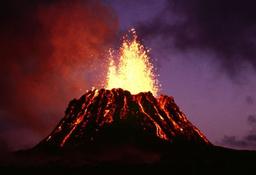
Volcano Test Review
Quiz by Karl Dietl
Feel free to use or edit a copy
includes Teacher and Student dashboards
Measure skillsfrom any curriculum
Measure skills
from any curriculum
Tag the questions with any skills you have. Your dashboard will track each student's mastery of each skill.
With a free account, teachers can
- edit the questions
- save a copy for later
- start a class game
- automatically assign follow-up activities based on students’ scores
- assign as homework
- share a link with colleagues
- print as a bubble sheet
10 questions
Show answers
- Q1If magma is basaltic, it is ___________ in silica.HighLow120s
- Q2What kind of volcano is this?ShieldCompositeMoundCinder Cone120s
- Q3If a magma is high in silica, it has _____________ viscosity.LowHigh120s
- Q4How do volcanoes form at convergent plate boundaries?Magma rises up between two plates.Magma pushes up through the crust in the middle of a plate.One plate subducts under another, melting into magma, which rises.120s
- Q5What kind of volcano is this?PointyCompositeCinder ConeShield120s
- Q6How do volcanoes form at divergent plate boundaries?One plate subducts under another, melting into magma.Magma flows up between plates.Lava pushes up through cracks in the middle of the plate.120s
- Q7What kind of volcano is this?ShieldCompositeCinder Cone120s
- Q8How are volcanoes formed at hot spots?One plate subducts under another, melting into magma.Magma rises up between two plates.Magma pushes up through the crust in the middle of a plate.120s
- Q9If an eruption is explosive, it MUST have a high amount of __________ in the magma.basalttephracindersgas120s
- Q10Where do volcanoes USUALLY form?In the northern hemisphereWherever they feel likeOn the equatorAlong plate boundaries120s